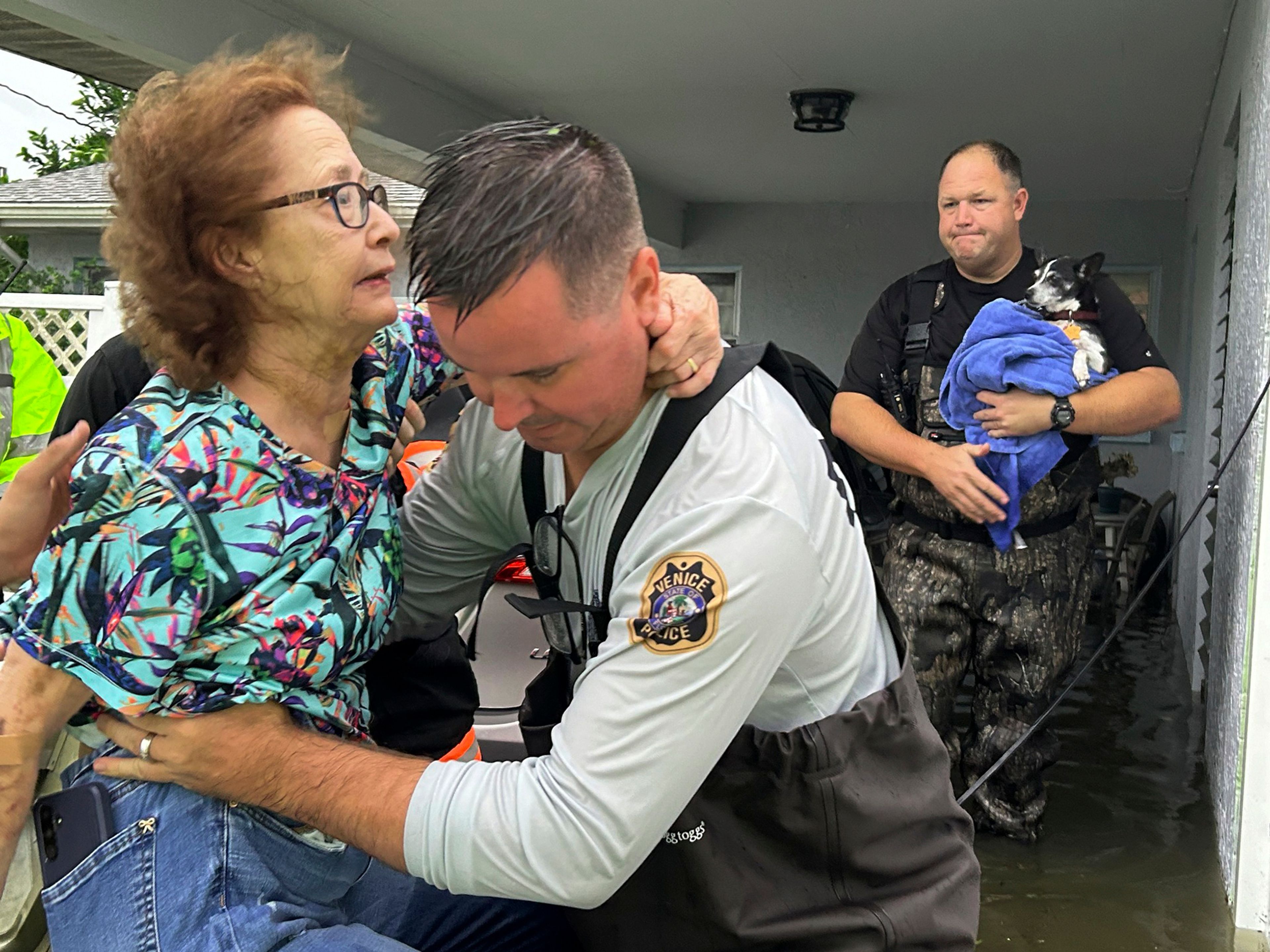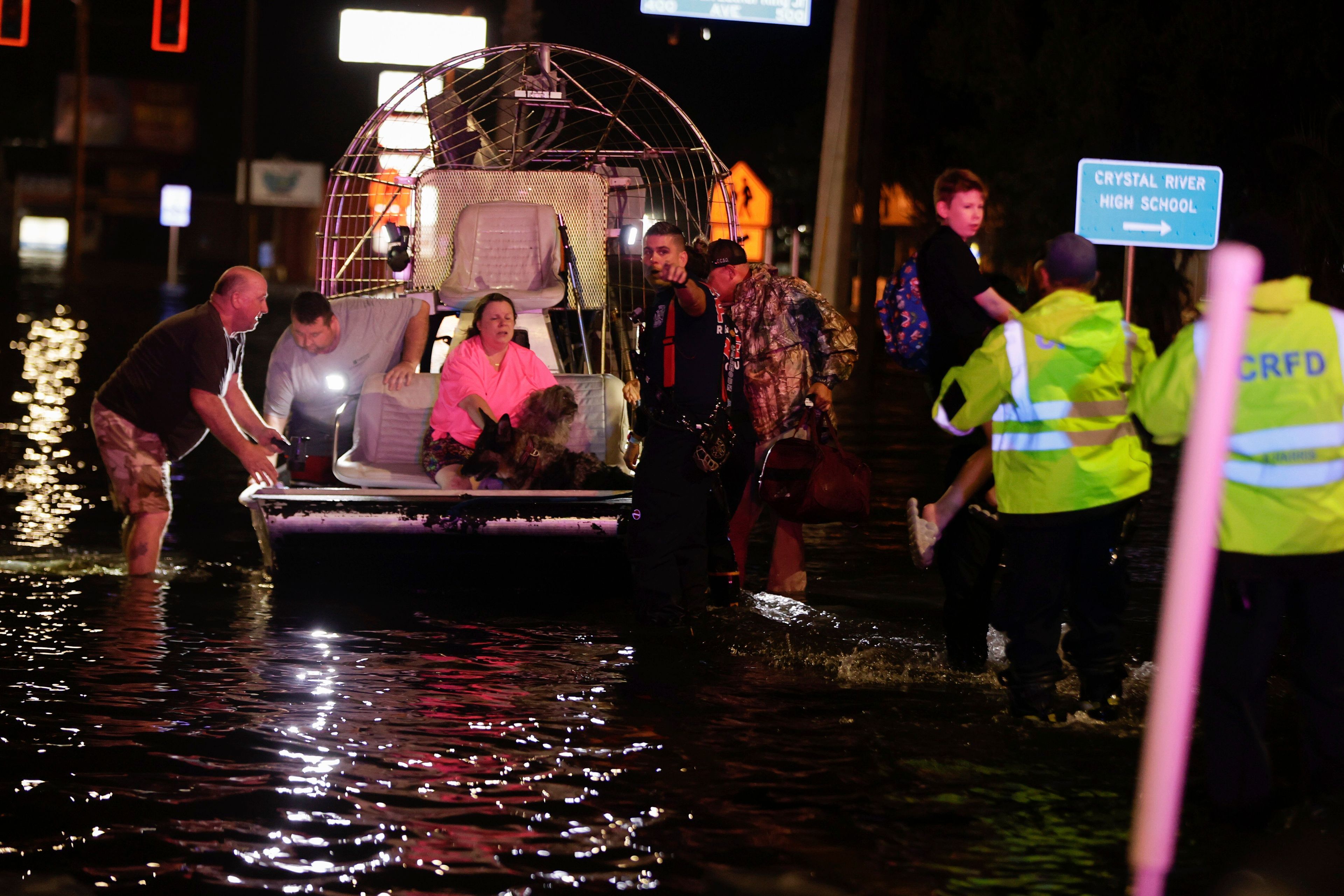Rescuers race to free people trapped by Hurricane Helene after storm kills at least 35 in 4 states
Hurricane Helene devastates southeastern U.S., killing at least 35 and leaving millions without power. Rescuers race against time to save those trapped by floodwaters as the storm's aftermath unfolds.
CRAWFORDVILLE, Fla. (AP) — Hurricane Helene left an enormous path of destruction across Florida and the entire southeastern U.S. on Friday, killing at least 35 people in four states, snapping trees like twigs, tearing apart homes and sending rescue crews on desperate missions to save people from floodwaters.
Georgia Gov. Brian Kemp said dozens of people were still trapped in buildings damaged by the Category 4 hurricane. The storm had maximum sustained winds of 140 mph (225 kph) when it made landfall late Thursday in a sparsely populated region in Florida’s rural Big Bend area, home to fishing villages and vacation hideaways where Florida’s Panhandle and peninsula meet.
The damage extended hundreds of miles to the north, with flooding as far away as northeast Tennessee, where a “dangerous rescue situation” was unfolding after 54 people were moved to the roof of the Unicoi County Hospital while rapid waters flooded the facility, according to Ballad Health.
In North Carolina, a lake used in the movie “Dirty Dancing” overtopped a dam. People in surrounding neighborhoods were evacuated, although there were no immediate concerns it was about to fail.
Multiple hospitals in southern Georgia were without power, and authorities were “having a hard time getting to places” so teams with chainsaws were “working to free up roads,” Kemp told a news conference.
Helene’s devastation comes as climate change exacerbates conditions that allow such storms to thrive, rapidly intensifying in warming waters and turning into powerful hurricanes and typhoons, sometimes in a matter of hours.
“Thank God we’re both alive to tell about it,” Rhonda Bell said after a towering oak tree smashed through the roof of her home in Valdosta, Georgia.
All five who died in one Florida county were in neighborhoods where residents had been told to evacuate, said Bob Gualtieri, the sheriff in Pinellas County in the St. Petersburg area. He said people who stayed because they didn’t believe the warnings wound up hiding in their attics to escape the rising water.
“We tried to launch boats, we tried to use high-water vehicles and we just met with too many obstacles,” Gualtieri said. He said the death toll could rise as emergency crews go door-to-door in the flooded areas.
Increasing numbers of deaths also were reported in Georgia and the Carolinas.
Video on social media sites showed sheets of rain coming down and siding coming off buildings in Perry, Florida, near where the storm arrived. One news station showed a home that was overturned, and many communities established curfews.
“It’s really heartbreaking,” said Stephen Tucker, after the hurricane peeled off the brand-new roof of a church in Perry that had been replaced after Hurricane Idalia last year.
Florida Gov. Ron DeSantis said the damage from Helene appeared to be greater than the combined damage of Idalia and Hurricane Debby in August. “It’s demoralizing,” he said.
President Joe Biden said he was praying for survivors as the head of the Federal Emergency Management Agency headed to the area. The agency has deployed more than 1,500 workers, and they helped with 400 rescues by late morning.
In Tampa, some areas could be reached only by boat. Officials elsewhere warned that the water could contain live wires, sewage, sharp objects and other debris.
“If you are trapped and need help please call for rescuers – DO NOT TRY TO TREAD FLOODWATERS YOURSELF,” the sheriff’s office in Citrus County, Florida, warned in a Facebook post.
More than 4 million homes and businesses were without power Friday morning in Florida, Georgia and South Carolina, according to poweroutage.us, which tracks utility reports.
In Georgia, an electrical utility group is warning of “catastrophic” damage to Georgia’s utility infrastructure. The Georgia Electric Membership Corp., which represents the state’s electric cooperatives, said the hurricane damaged more than 100 high voltage transmission lines and that more than 60 substations were out of service.
The hurricane came ashore near the mouth of the Aucilla River on Florida’s Gulf Coast. That location was only about 20 miles (32 kilometers) northwest of where Idalia hit last year at nearly the same ferocity, causing widespread damage.
Atlanta was drenched, with car roofs poking out of the water in some neighborhoods.
As the hurricane’s eye passed near Valdosta, Georgia, a city of 55,000 near the Florida line, dozens of people huddled early Friday in a darkened hotel lobby. “We heard some rumbling,” said Fermin Herrera, 20, cradling his sleeping 2-month-old daughter in his arms.
Helene is the third storm to strike the city in just over a year. Tropical Storm Debby blacked out power to thousands in August, while Hurricane Idalia damaged an estimated 1,000 homes in Valdosta and surrounding Lowndes County a year ago. Now some downtown storefront windows were shattered and store awnings mangled.
Soon after it crossed over land, Helene weakened to a tropical storm, then weakened again to a tropical depression. Forecasters said it continued to produce catastrophic flooding, and raised the risk of mudslides in the Appalachian Mountains. Some areas received more than a foot of rain.
In North Carolina, forecasters warned of flooding that could be worse than anything seen in the past century. Evacuations were underway in several areas of the state Friday, and around 300 roads were closed. The Connecticut Army National Guard sent a helicopter to help.
“It’s terrible. I don’t know if I will ever see anything like this again,” said Spencer Tate Andrews, of Asheville, North Carolina.
School districts and multiple universities canceled classes. Airports in Florida that closed were to reopen Friday, and inspectors were out examining bridges and causeways along the Gulf Coast to get them back open to traffic quickly, the state’s transportation secretary said.
Helene earlier swamped parts of Mexico’s Yucatan Peninsula, flooding streets and toppling trees as it brushed the resort city of Cancun and passed offshore. In western Cuba, Helene knocked out power to more than 200,000 homes and businesses as it brushed past the island.
Helene was the eighth named storm of the Atlantic hurricane season, which began June 1. The National Oceanic and Atmospheric Administration has predicted an above-average Atlantic hurricane season this year because of record-warm ocean temperatures.
___
Payne reported from Tallahassee, Florida, and Hollingsworth reported from Kansas City, Missouri. Associated Press journalists Seth Borenstein in New York; Jeff Amy in Atlanta; Russ Bynum in Valdosta, Georgia; Danica Coto in San Juan, Puerto Rico; Andrea Rodríguez in Havana; Mark Stevenson and María Verza in Mexico City; and Claire Rush in Portland, Oregon, contributed to this report.
Connect with the Southeast Missourian Newsroom:
For corrections to this story or other insights for the editor, click here. To submit a letter to the editor, click here. To learn about the Southeast Missourian’s AI Policy, click here.


































